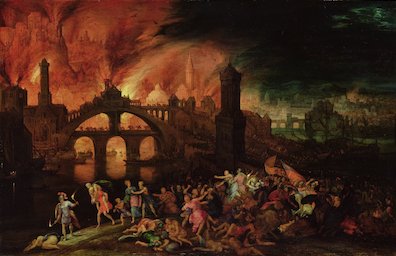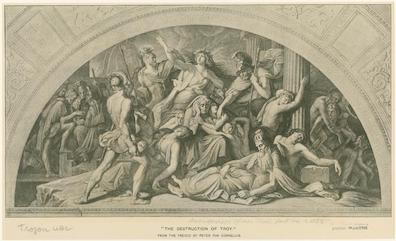In Helen of Joyce (Printwell Books, 2022), Senan
Molony argues that Joyce's novel draws not only on the story
of Odysseus's long journey back from Troy but also on stories
from the previous decade when he helped lead the Greek host
besieging the city and devised the stratagem of putting armed
warriors inside a statue. The opening paragraphs of Telemachus
surreptitiously name Troy and also evoke the wooden horse.
Mulligan's face is "equine in its length" and his hair
is "grained and hued like pale oak." Molony notes that
"hued" imports a pun on "hewed," evoking the cutting down of
trees and the cutting down of Trojans. The razor in the
chapter's first sentence contributes to the atmosphere:
"Mulligan folds his razor (it's therefore a cut-throat, even
though safety versions were available in 1904)" (22), and many
of Troy's warriors "had their throats cut as they slept" (19).
The intimations of violence continue in the living room of
the tower. Mulligan serves up breakfast as if he is
slaughtering men: "He hacked through the fry on
the dish"; "hewing thick slices from the loaf" (that
word again), and "hewing" some more, "He lunged
towards his messmates in turn a thick slice of bread, impaled
on his knife"; "he growled in a hoarsened
rasping voice as he hewed again vigorously at
the loaf." This action takes place as the room fills with "a
cloud of coalsmoke and fumes of fried grease," choking
the inhabitants and evoking the smoke that filled Troy after
it had been put to the torch. (Molony notes a lovely pun on
"grease.") There are plenty of violent deaths in the Odyssey
and Hamlet, but nothing quite like this. Other details
in the chapter add to the cumulative impression of violent
havoc: Stephen's nickname, "Kinch, the knife-blade"; his
purported killing of his mother;
Haines's effort to shoot a black panther during the
terrible nighttime darkness in the stone chamber. It seems
that three killers are loose inside the tower.
Molony cites still other details that line up with stories of
the expeditionary assault on Troy. Quoting from the Anabasis,
Mulligan declaims "Thalatta! Thalatta!" In
Homeric Greek it would be "Thalassa!," but Xenophon's
image of Greek warriors reaching the Black Sea coast and
celebrating their escape from Anatolia readily maps onto
Homer's story of a Greek expedition to the opposite,
northwestern corner of Asia Minor. Leaving behind the plains
of Troy, the Greeks might well have exclaimed "The sea! The
sea!" twice––once at the fleet's deceptive departure, when it
left the wooden horse behind on the shore, and a second time
when the ships sailed full of gold and bronze spoils and
enslaved women. These departures also resonate when Mulligan
tells Stephen that "We must go to Athens."
Less persuasive, to me, are Molony's claims that the "wetted
ashes" of Stephen's dream recall the wetted ashes of
mourning that Hecuba put on her head when she was led into
slavery, that the word "noserag" contains a "garrison" when
read backward and likewise that the "lemon" is a Molly-like
"melon," that Stephen's "trousers" evoke Troy (though Joyce
did write in Finnegans Wake, "Gricks may rise and
Troysirs fall"!), and that the story of Iphigenia at Aulis
underlies a series of superficially similar events at
Sandycove. (The pestilence at Aulis, Molony argues, is evoked
by Mulligan's complaint that Irish people are diseased from
"Living in a bogswamp." Agamemnon's killing of a deer sacred
to Artemis surfaces in the name Buck Mulligan. The need to pay
the milkwoman's bill recalls the restitution due to Artemis.
The "freshened" wind outside the Martello tower, and
Mulligan's plunge into the sea, reenact the fleet's escape
from Aulis.)
Molony's Introduction suggests that the Iliad may be
as important to Joyce as the Odyssey, but the echoes
of Troy in Telemachus do not involve any allusions to
that work. The story of Iphigenia is only darkly alluded to in
book 1, and the construction of the wooden horse and its
terrible aftermath, which take place after the epic's
conclusion, receive no mention at all. The stories of
murdering, pillaging, and burning that fired Joyce's
imagination would have come, as Molony recognizes, not from
the Iliad but from book 2 of Virgil's Aeneid.
But his larger point is that Joyce set out in Ulysses
to represent all of the Greek hero's deeds––not just
the voyage back to Ithaca but the long preceding struggle to
take Troy, concluding with the inspired stratagem of the
horse. This insight is brilliant and long overdue. After
setting the scene in the first chapter, Helen of Joyce
builds toward revealing the narrative use to which Joyce put
the symbolic analogue: making 7 Eccles Street a stronghold
taken by the enemy, its female prize captured.
Joyce told Frank Budgen that he was working on a book "based
on the wanderings of Ulysses. The Odyssey, that is to say,
serves me as a ground plan. Only my time is recent time and
all my hero's wanderings take no more than eighteen hours"
(15). But as Molony notes, he also told Budgen that Ulysses
"was an inventor too. The tank is his creation. Wooden horse
or iron box––it doesn't matter. They are both shells
containing armed warriors" (17). The idea of an "equine"
shell of "pale oak" unleasing holy hell on a sleeping
city grew into something ripe with symbolic possibilities.
Joyce's genius was great enough to encompass both parts of the
hero's story: the search for a meaningful home in an alien
universe, and the risk to an entire established order posed by
competition for a woman's affection. "Make room in the bed,"
says Mulligan before diving into the fortyfoot. There is room
in the bed not just for the wanderer but for the adventurer
who invades his home.




